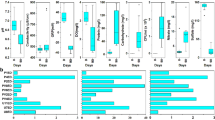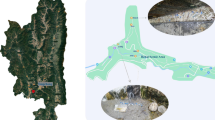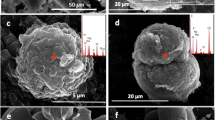Abstract
Microbes can be found in hypersaline environments forming diverse populations with complex ecological interactions. Microbes in such environments were found to be involved in the formation of minerals including dolomite, a mineral of economic importance and whose origin has been long-debated. Various reports on in vitro experiments using pure cultures provided evidence for the microbial role in dolomite formation. However, culturing experiments have been limited in scope and do not fully address the possible interactions of the naturally occurring microbial communities; consequently, the ability of microbes as a community to form dolomite has been investigated in this study. Our experiments focused on examining the microbial composition by culturing aerobic heterotrophs from the top hypersaline sediments of Al-Khiran sabkha in Kuwait, a modern dolomite-forming environment. The objectives of this study were to assess the ability of two microbial consortia to form dolomite using enrichment culture experiments, mineralogy, and metagenomics. Proto-dolomite was formed by a microbial community dominated by Halomonas strains whereby degradation of the extracellular polymeric substances (EPS) was observed and the pH changed from 7.00 to 8.58. Conversely, proto-dolomite was not observed within a microbial community dominated by Clostridiisalibacter in which EPS continuously accumulated and the pH slightly changed from 7.00 to 7.29.









Similar content being viewed by others
Data availability
Metagenomic sequences are submitted to NCBI under SRA Accession No. PRJNA551135.
References
Al-Disi ZA, Jaoua S, Bontognali TRR, Attia ESM, Al-Kuwari HAAS, Zouari N (2017) Evidence of a role for aerobic bacteria in high magnesium carbonate formation in the evaporitic environment of Dohat Faishakh sabkha in Qatar. Front Environ Sci 5:1. https://doi.org/10.3389/fenvs.2017.00001
Al-Sammar HF (2009) A study on the seasonal changes of dominance and physiological adaptations of salt tolerant fungi from natural salt ponds and coastal sabkha in Kuwait. Thesis Kuwait University
Arahal DR, Ventosa A (2006) The Family Halomonadaceae. In: Dworkin M, Falkow S, Rosenberg E, Schleifer K, Stackebrandt E (eds) The Prokaryotes. Springer, New York, pp 811–835. doi:10.1007/0-387-30746-x_28
Arp G, Thiel V, Reimer A, Michaelis W, Reitner J (1999) Biofilm exopolymers control microbialite formation at thermal springs discharging into the alkaline Pyramid Lake, Nevada, USA. Sediment Geol 126:159–176
Benzerara K, Miot J, Morin G, Ona-Nguema G, Skouri-Panet F, Férard C (2011) Significance, mechanisms and environmental implications of microbial biomineralization. Comptes Rendus Geosci 343:160–167. https://doi.org/10.1016/j.crte.2010.09.002
Berry D, Widder S (2014) Deciphering microbial interactions and detecting keystone species with co-occurrence networks. Front Microbiol 5:219. https://doi.org/10.3389/fmicb.2014.00219
Bontognali TRR, Vasconcelos C, Warthmann RJ, Bernasconi SM, Dupraz C, Strohmenger CJ, McKenzie JA (2010) Dolomite formation within microbial mats in the coastal sabkha of Abu Dhabi (United Arab Emirates). Sedimentology 57:824–844. https://doi.org/10.1111/j.1365-3091.2009.01121.x
Bontognali TRR, Vasconcelos C, Warthmann RJ, Lundberg R, McKenzie JA (2012) Dolomite-mediating bacterium isolated from the sabkha of Abu Dhabi (UAE). Terra Nova 24:248–254. https://doi.org/10.1111/j.1365-3121.2012.01065.x
Bontognali TRR, McKenzie JA, Warthmann RJ, Vasconcelos C (2014) Microbially influenced formation of Mg-calcite and Ca-dolomite in the presence of exopolymeric substances produced by sulphate-reducing bacteria. Terra Nova 26:72–77. https://doi.org/10.1111/ter.12072
Bouchotroch S, Quesada E, del Moral A, Llamas I, Béjar V (2001) Halomonas maura sp. nov., a novel moderately halophilic, exopolysaccharide-producing bacterium. Int J Syst Evol Microbiol 51:1625–1632
Braissant O, Decho AW, Dupraz C, Glunk C, Przekop KM, Visscher PT (2007) Exopolymeric substances of sulfate-reducing bacteria: interactions with calcium at alkaline pH and implication for formation of carbonate minerals. Geobiology 5:401–411. https://doi.org/10.1111/j.1472-4669.2007.00117.x
Brauchli M, McKenzie JA, Strohmenger CJ, Sadooni F, Vasconcelos C, Bontognali TRR (2016) The importance of microbial mats for dolomite formation in the Dohat Faishakh sabkha, Qatar. Carbonate Evaporite 31:339–345. https://doi.org/10.1007/s13146-015-0275-0
Cao L, Caldeira K, Jain AK (2007) Effects of carbon dioxide and climate change on ocean acidification and carbonate mineral saturation. Geophys Res Lett. https://doi.org/10.1029/2006gl028605
Caporaso JG et al (2010) QIIME allows analysis of high-throughput community sequencing data. Nat Methods 7:335–336. https://doi.org/10.1038/nmeth.f.303
Curtis R, Evans G, Kinsman DJJ, Shearman DJ (1963) Association of dolomite and anhydrite in the recent sediments of the Persian Gulf. Nature 197:679–680
Decho AW (2000) Microbial biofilms in intertidal systems: an overview. Cont Shelf Res 20:1257–1273
Delattre H, Desmond-Le Quéméner E, Duquennoi C, Filali A, Bouchez T (2019) Consistent microbial dynamics and functional community patterns derived from first principles. ISME J 13:263–276. https://doi.org/10.1038/s41396-018-0272-0
Deng S, Dong H, Lv G, Jiang H, Yu B, Bishop ME (2010) Microbial dolomite precipitation using sulfate reducing and halophilic bacteria: results from Qinghai Lake, Tibetan Plateau, NW China. Chem Geol 278:151–159. https://doi.org/10.1016/j.chemgeo.2010.09.008
DeSantis TZ et al (2006) Greengenes, a chimera-checked 16S rRNA gene database and workbench compatible with ARB. Appl Environ Microbiol 72:5069–5072. https://doi.org/10.1128/AEM.03006-05
DiLoreto ZA et al (2019) Microbial community composition and dolomite formation in the hypersaline microbial mats of the Khor Al-Adaid sabkhas, Qatar. Extremophiles 23:201–218. https://doi.org/10.1007/s00792-018-01074-4
Diver WL (1974) Precambrian microfossils of Carpentarian age from Bungle Bungle dolomite of western Australia. Nature 247:361
Dohi M, Mougi A (2018) A coexistence theory in microbial communities. R Soc Open Sci 5:180476. https://doi.org/10.1098/rsos.180476
Douglas S (2005) Mineralogical footprints of microbial life. Am J Sci 305:503–525
Dupraz C, Reid RP, Braissant O, Decho AW, Norman RS, Visscher PT (2009) Processes of carbonate precipitation in modern microbial mats. Earth-Sci Rev 96:141–162. https://doi.org/10.1016/j.earscirev.2008.10.005
Edgar RC (2018) Accuracy of taxonomy prediction for 16S rRNA and fungal ITS sequences. PeerJ 6:e4652. https://doi.org/10.7717/peerj.4652
Eriksson PG, Sarkar S, Samanta P, Banerjee S, Porada H, Catuneanu O (2010) Paleoenvironmental context of microbial mat-related structures in siliciclastic rocks. In: Seckbach J, Oren A (eds) Microbial mats. Cellular origin, life in extreme habitats and astrobiology. vol 14, Springer, Dordrecht, pp 73–108.
Ewing B, Green P (1998) Base-calling of automated sequencer traces using phred. II Error Probab Genome Res 8:186–194
Ewing B, Hillier L, Wendl MC, Green P (1998) Base-calling of automated sequencer traces using phred. I. Accuracy assessment. Genome Res 8:175–185
Falkowski PG, Fenchel T, Delong EF (2008) The microbial engines that drive Earth's biogeochemical cycles. Science 320:1034–1039
Faust K, Raes J (2012) Microbial interactions: from networks to models. Nat Rev Microbiol 10:538–550. https://doi.org/10.1038/nrmicro2832
Fuhrman JA (2009) Microbial community structure and its functional implications. Nature 459:193–199. https://doi.org/10.1038/nature08058
Gadd GM (2010) Metals, minerals and microbes: geomicrobiology and bioremediation. Microbiology 156:609–643. https://doi.org/10.1099/mic.0.037143-0
Gallagher KL, Braissant O, Kading TJ, Dupraz C, Visscher PT (2013) Phosphate-related artifacts in carbonate mineralization experiments. J Sediment Res 83:37–49. https://doi.org/10.2110/jsr.2013.9
González-Domenech CM, Martínez-Checa F, Béjar V, Quesada E (2010) Denitrification as an important taxonomic marker within the genus Halomonas. Syst Appl Microbiol 33:85–93. https://doi.org/10.1016/j.syapm.2009.12.001
Gregg JM, Bish DL, Kaczmarek SE, Machel HG (2015) Mineralogy, nucleation and growth of dolomite in the laboratory and sedimentary environment: a review. Sedimentology 62:1749–1769. https://doi.org/10.1111/sed.12202
Gunatilaka A, Saleh A, Al-Temeemi A, Nassar N (1984) Occurrence of subtidal dolomite in a hypersaline lagoon, Kuwait. Nature 311:450–452
Gunatilaka A, Saleh A, Al-Temeemi A, Nassar N (1987) Calcium-poor dolomite from the sabkhas of Kuwait. Sedimentology 34:999–1006
Haferburg G, Kothe E (2007) Microbes and metals: interactions in the environment. J Basic Microbiol 47:453–467. https://doi.org/10.1002/jobm.200700275
Ionescu D et al (2015) Calcium dynamics in microbialite-forming exopolymer-rich mats on the atoll of Kiritimati, Republic of Kiribati, Central Pacific. Geobiology 13:170–180. https://doi.org/10.1111/gbi.12120
Kaczmarek SE, Gregg JM, Bish DL, Machel HG, Fouke BW (2017) Dolomite, very high-magnesium calcite, and microbes- Implications for the microbial model of dolomitization. In: Macneil AJ, Lonnee J, Wood R (eds) Characterization and Modeling of Carbonates–Mountjoy Symposium 1. SEPM Society for Sedimentary Geology, SEPM Special Publication No. 109, pp 7–20
Kanehisa M, Furumichi M, Tanabe M, Sato Y, Morishima K (2017) KEGG: new perspectives on genomes, pathways, diseases and drugs. Nucleic Acids Res 45:D353–D361. https://doi.org/10.1093/nar/gkw1092
Kenward PA, Fowle DA, Goldstein RH, Ueshima M, González LA, Roberts JA (2013) Ordered low-temperature dolomite mediated by carboxyl-group density of microbial cell walls. AAPG Bull 97:2113–2125. https://doi.org/10.1306/05171312168
Knowles R (1982) Denitrification. Microbiol Rev 46:43–70
Krause S, Liebetrau V, Gorb S, Sánchez-Román M, McKenzie JA, Treude T (2012) Microbial nucleation of Mg-rich dolomite in exopolymeric substances under anoxic modern seawater salinity: New insight into an old enigma. Geology 40:587–590. https://doi.org/10.1130/g32923.1
Land LS (1998) Failure to precipitate dolomite at 25°C from dilute solution despite 1000-fold oversaturation after 32 years. Aquat Geochem 4:361–368
Langille MG et al (2013) Predictive functional profiling of microbial communities using 16S rRNA marker gene sequences. Nat Biotechnol 31:814–821. https://doi.org/10.1038/nbt.2676
Lian B, Yuan D, Liu Z (2011) Effect of microbes on karstification in karst ecosystems. Chin Sci Bull 56:3743–3747. https://doi.org/10.1007/s11434-011-4648-z
Liebgott PP et al (2008) Clostridiisalibacter paucivorans gen. nov., sp. nov., a novel moderately halophilic bacterium isolated from olive mill wastewater. Int J Syst Evol Microbiol 58:61–67. https://doi.org/10.1099/ijs.0.65182-0
Lin CY, Turchyn AV, Steiner Z, Bots P, Lampronti GI, Tosca NJ (2018) The role of microbial sulfate reduction in calcium carbonate polymorph selection. Geochim Cosmochim Ac 237:184–204. https://doi.org/10.1016/j.gca.2018.06.019
Lindgreen S, Adair KL, Gardner PP (2016) An evaluation of the accuracy and speed of metagenome analysis tools. Sci Rep 6:19233. https://doi.org/10.1038/srep19233
Liu D, Xu Y, Papineau D, Yu N, Fan Q, Qiu X, Wang H (2019) Experimental evidence for abiotic formation of low-temperature proto-dolomite facilitated by clay minerals. Geochim Cosmochim Ac 247:83–95. https://doi.org/10.1016/j.gca.2018.12.036
Lozupone CA, Stombaugh JI, Gordon JI, Jansson JK, Knight R (2012) Diversity, stability and resilience of the human gut microbiota. Nature 489:220–230. https://doi.org/10.1038/nature11550
Malone MJ, Baker PA, Burns SJ (1996) Recrystallization of dolomite: an experimental study from 50–200 °C. Geochim Cosmochim Ac 60:2189–2207
Obst M, Wehrli B, Dittrich M (2009) CaCO3 nucleation by cyanobacteria: laboratory evidence for a passive, surface-induced mechanism. Geobiology 7:324–347. https://doi.org/10.1111/j.1472-4669.2009.00200.x
Oren A (2011) Diversity of halophiles. In: Horikoshi K (ed) Extremophiles handbook. 1 edn, Springer, Japan, pp 310–325. doi:10.1007/978-4-431-53898-1_3.2
Oren A (2013) Life at high salt concentrations. In: Rosenberg E, DeLong EF, Lory S, Stackebrandt E, Thompson F (eds) The prokaryotes—prokaryotic communities and ecophysiology. Springer-Verlag, Berlin Heidelberg, pp 421–440. 10.1007/978-3-642-30123-0_57
Paulo C, Dittrich M (2013) 2D Raman spectroscopy study of dolomite and cyanobacterial extracellular polymeric substances from Khor Al-Adaid sabkha (Qatar). J Raman Spectrosc 44:1563–1569. https://doi.org/10.1002/jrs.4368
Perri E, Tucker M (2007) Bacterial fossils and microbial dolomite in Triassic stromatolites. Geology 35:207–210. https://doi.org/10.1130/g23354a.1
Perri E, Tucker ME, Spadafora A (2012) Carbonate organo-mineral micro- and ultrastructures in sub-fossil stromatolites: Marion lake, South Australia. Geobiology 10:105–117. https://doi.org/10.1111/j.1472-4669.2011.00304.x
Phoenix VR, Martinez RE, Konhauser KO, Ferris FG (2002) Characterization and implications of the cell surface reactivity of Calothrix sp. strain KC97. Appl Environ Microbiol 68:4827–4834. https://doi.org/10.1128/aem.68.10.4827-4834.2002
Qiu X, Wang H, Yao Y, Duan Y (2017) High salinity facilitates dolomite precipitation mediated by Haloferax volcanii DS52. Earth Planet Sci Lett 472:197–205. https://doi.org/10.1016/j.epsl.2017.05.018
Qurashi AW, Sabri AN (2012) Biofilm formation in moderately halophilic bacteria is influenced by varying salinity levels. J Basic Microbiol 52:566–572. https://doi.org/10.1002/jobm.201100253
Ramel F, Brasseur G, Pieulle L, Valette O, Hirschler-Réa A, Fardeau ML, Dolla A (2015) Growth of the obligate anaerobe Desulfovibrio vulgari Hildenborough under continuous low oxygen concentration sparging: impact of the membrane-bound oxygen reductases. PLoS ONE 10:e0123455. https://doi.org/10.1371/journal.pone.0123455
Rivadeneyra A, Gonzalez-Martinez A, Portela GR, Martin-Ramos DJ, Gonzalez-Lopez J, Rivadeneyra MA (2017) Biomineralisation of carbonate and sulphate by the halophilic bacterium Halomonas maura at different manganese concentrations. Extremophiles 21:1049–1056. https://doi.org/10.1007/s00792-017-0965-8
Rodriguez-Blanco JD, Shaw S, Benning LG (2015) A route for the direct crystallization of dolomite. Am Mineral 100:1172–1181. https://doi.org/10.2138/am-2015-4963
Rousk J et al (2010) Soil bacterial and fungal communities across a pH gradient in an arable soil. ISME J 4:1340–1351. https://doi.org/10.1038/ismej.2010.58
Sánchez-Román M, Vasconcelos C, Schmid T, Dittrich M, McKenzie JA, Zenobi R, Rivadeneyra MA (2008) Aerobic microbial dolomite at the nanometer scale: Implications for the geologic record. Geology 36:879–882. https://doi.org/10.1130/g25013a.1
Sánchez-Román M, McKenzie JA, de Luca-Rebello-Wagener A, Rivadeneyra MA, Vasconcelos C (2009) Presence of sulfate does not inhibit low-temperature dolomite precipitation. Earth Planet Sci Lett 285:131–139. https://doi.org/10.1016/j.epsl.2009.06.003
Sass H, Cypionka H (2004) Isolation of sulfate-reducing bacteria from the terrestrial deep subsurface and description of Desulfovibrio cavernae sp. nov. Syst Appl Microbiol 27:541–548. https://doi.org/10.1078/0723202041748181
Shin N-R, Whon TW, Kim M-S, Roh SW, Jung M-J, Kim Y-O, Bae J-W (2012) Ornithinibacillus scapharcae sp. nov., isolated from a dead ark clam. Antonie Van Leeuwenhoek 101:147–154. https://doi.org/10.1007/s10482-011-9645-3
Shivanand P, Mugeraya G (2011) Halophilic bacteria and their compatible solutes—osmoregulation and potential applications. Curr Sci 100:1516–1521
The human microbiome project consortium (2012) Structure, function and diversity of the healthy human microbiome. Nature 486:207–214. https://doi.org/10.1038/nature11234
Truong DT et al (2015) MetaPhlAn2 for enhanced metagenomic taxonomic profiling. Nat Methods 12:902–903. https://doi.org/10.1038/nmeth.3589
van Lith Y, Warthmann R, Vasconcelos C, McKenzie JA (2003) Sulphate-reducing bacteria induce low-temperature Ca-dolomite and high Mg-calcite formation. Geobiology 1:71–79
Vasconcelos C, McKenzie JA (1997) Microbial mediation of modern dolomite precipitation and diagenesis under anoxic conditions (Lagoa Vermelha, Rio de Janeiro, Brazil). J Sediment Res 67:378–390
Vasconcelos C, McKenzie JA, Bernasconi S, Grujic D, Tien AJ (1995) Microbial mediation as a possible mechanism for natural dolomite formation at low temperatures. Nature 377:220–222
Wang Y-N, Cai H, Yu S-L, Wang Z-Y, Liu J, Wu X-L (2007) Halomonas gudaonensis sp. nov., isolated from a saline soil contaminated by crude oil. Int J Syst Evol Microbiol 57:911–915. https://doi.org/10.1099/ijs.0.64826-0
Wang LL et al (2012) pH dependence of structure and surface properties of microbial EPS. Environ Sci Technol 46:737–744. https://doi.org/10.1021/es203540w
Warren J (2000) Dolomite: occurrence, evolution and economically important associations. Earth-Sci Rev 52:1–81
Warthmann R, van Lith Y, Vasconcelos C, McKenzie JA, Karpoff AM (2000) Bacterially induced dolomite precipitation in anoxic culture experiments. Geology 28:1091–1094
Warthmann R, Vasconcelos C, Sass H, McKenzie JA (2005) Desulfovibrio brasiliensis sp. nov., a moderate halophilic sulfate-reducing bacterium from Lagoa Vermelha (Brazil) mediating dolomite formation. Extremophiles 9:255–261. https://doi.org/10.1007/s00792-005-0441-8
Weiner S, Dove PM (2003) An overview of biomineralization processes and the problem of the vital effect. Biomineralization 54:1–29
Whitehead NA, Barnard AML, Slater H, Simpson NJL, Salmond GPC (2001) Quorum-sensing in Gram-negative bacteria. FEMS Microbiol Rev 25:365–404. https://doi.org/10.1111/j.1574-6976.2001.tb00583.x
Wright DT (1999) The role of sulphate-reducing bacteria and cyanobacteria in dolomite formation in distal ephemeral lakes of the Coorong region, South Australia. Sediment Geol 126:147–157
Yang B, Wang Y, Qian PY (2016) Sensitivity and correlation of hypervariable regions in 16S rRNA genes in phylogenetic analysis. BMC Bioinform 17:135. https://doi.org/10.1186/s12859-016-0992-y
Zhang C, Li F, Li X, Li L, Liu L (2018) The roles of Mg over the precipitation of carbonate and morphological formation in the presence of Arthrobacter sp. strain MF-2. Geomicrobiol J 35:545–554. https://doi.org/10.1080/01490451.2017.1421727
Zhu T, Dittrich M (2016) Carbonate precipitation through microbial activities in natural environment, and their potential in biotechnology: a review. Front Bioeng Biotechnol 4:4. https://doi.org/10.3389/fbioe.2016.00004
Acknowledgements
This study was funded by the Kuwait Foundation for the Advancement of Sciences (KFAS) (Project Code: PR17-12SL-10) to HM and by the National Sciences and Engineering Research Council of Canada (NSERC) Discovery Grant to MD. The authors are solely responsible for the statements made in this publication. The authors would like to acknowledge Robert Temkin from the Department of Biological Sciences, University of Toronto Scarborough for his assistance with SEM imaging, George Kretschmann and Yanan Liu from the Department of Earth Sciences, University of Toronto for their assistance with conducting SEM-EDS, XRD, and EPMA analyses, and Susan Eapen for her assistance in laboratory work at Kuwait University.
Author information
Authors and Affiliations
Contributions
AA, DG, HM, and MD contributed to the conception of the research and study design. AA was responsible for conducting all laboratory experiments, collecting data, data analysis, and writing the manuscript. AA, DG, HM, and MD were involved in data interpretation and revising and approving the final draft of the manuscript to be published. AA, DG, HM, and MD agree to be accountable for all aspects of the work and ensuring that questions related to the accuracy or integrity of any part of the work are investigated and resolved appropriately.
Corresponding author
Ethics declarations
Conflict of interest
The authors declare that they have no conflict of interest.
Additional information
Communicated by A. Oren.
Publisher's Note
Springer Nature remains neutral with regard to jurisdictional claims in published maps and institutional affiliations.
Electronic supplementary material
Below is the link to the electronic supplementary material.
792_2019_1135_MOESM1_ESM.xlsx
ESM_1 Metagenomic taxonomic classification of microbial consortia using MetaPhlAn2 for ACM1 and ACM2 samples (XLSX 9 kb)
792_2019_1135_MOESM2_ESM.xlsx
ESM_2 Full-length 16S rRNA gene taxonomic classification of microbial consortia using QIIME for ACM1 and ACM2 samples (XLSX 19 kb)
792_2019_1135_MOESM3_ESM.xlsx
ESM_3 Halomonas strains taxonomic classification and 16S rRNA gene, partial sequences for ACM1 and ACM2 samples (XLSX 24 kb)
Rights and permissions
About this article
Cite this article
Alibrahim, A., Al-Gharabally, D., Mahmoud, H. et al. Proto-dolomite formation in microbial consortia dominated by Halomonas strains. Extremophiles 23, 765–781 (2019). https://doi.org/10.1007/s00792-019-01135-2
Received:
Accepted:
Published:
Issue Date:
DOI: https://doi.org/10.1007/s00792-019-01135-2




